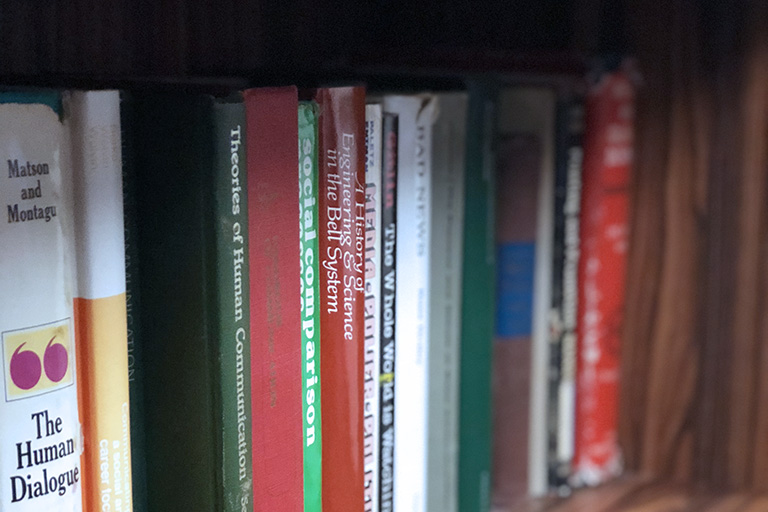Bente, G., Krämer, N. C., Petersen, A., & de Ruiter, J. P. (2001). Computer animated movement and person perception: Methodological advances in nonverbal behavior research. Journal of Nonverbal Behavior, 25(3), 151-166.
Bente, G., Petersen, A., Krämer, N. C., & de Ruiter, J. P. (2001). Transcript-based computer animation of movement: Evaluating a new tool for nonverbal behavior research. Behavior Research Methods, Instruments, & Computers, 33(3), 303-310.
Bresnahan, M.J, Inoue, Y., Liu, W.Y., & Nishida, T. (2001). Changing gender roles in prime-time television commercials in Japan, Taiwan, Malaysia and the US. Sex Roles 12, 117-131.
Bresnahan, M.J., Ohashi, R., Nebashi, R., Liu, W.Y., & Liao, C.C. (2001). Assertiveness as a predictor of compliance and resistance in Taiwan, Japan, and the U.S. Journal of Asian Pacific Communication, 11, 135-159.
Bresnahan, M.J., Ohashi, R., Nebashi, R., Liu, W.Y., & Shearman, S.M. (2001). Attitudinal and affective response toward accented English. Language and Communication, 12, 1-15.
Boster, F.J., Fediuk, T.A., & Kotowski, M.R. (2001). The effectiveness of an altruistic appeal in the presence and absence of favors. Communication Monographs, 68, 340-346.
Chory-Assad R.M. & Tamborini, R. (2001). Television doctors: An analysis of physicians in fictional and non-fictional television programs. Journal of Broadcasting & Electronic Media, 45, (3), 499-522.
Donohue, W.A. (2001). Resolving relational paradox: The language of conflict in relationships. In W. F. Eadie and P. E. Nelson (Eds.), The language of conflict and resolution (pp. 21-46). Thousand Oaks, CA: Sage.
Hullett, C.R., & Boster, F.J. (2001). Matching messages to the values underlying value-expressive and social-adjustive attitudes: Reconciling an old theory with a contemporary measurement approach. Communication Monographs, 68, 133-153.
Johnson, J.D., Donohue, W.A., Atkin, C.K., & Johnson, S. (2001) Communication, involvement, and perceived innovativeness: Tests of a model with two contrasting innovations. Group and Organization Management, 26, 24-52.
LaFrance, B.H., & Boster, F.J. (2001). To match or mismatch? That is only one important question. Communication Monographs, 68, 211- 234.
Lapinski, M.K., & Boster, F.J. (2001). Modeling the ego-defensive function of attitudes. Communication Monographs, 68, 314-324.
Lapinski, M.K. & Mastro, D. (2001). A social identity approach to understanding the jury decision-making process: Race as a social indicator. The Journal of Intergroup Relations, 2 48-62.
Levine, T.R., & Boster, F.J. (2001). The effects of power and message variables on compliance. Communication Monographs, 68, 28-48.
Limon, M.S., & Boster, F.J. (2001). The impact of varying argument quality and minority size on influencing the majority and perceptions of the minority. Communication Quarterly, 49, 350- 365.
Medved, C.E., Morrison, K., Dearing, J.W., Larson, R.S., Cline, G., & Brummans, B. (2001). Tensions in community health improvement initiatives: Communication and collaboration in a managed care environment. Journal of Applied Communication Research, 29, 137-152.
Roberto, A.J., Meyer, G., & Boster, F.J. (2001). Predicting adolescents’ decisions about fighting: A test of the theory of planned behavior. Communication Research Reports, 18, 315-323.
Sherry, J.L. (2001). The effects of violent video games on aggression: A meta-analysis. Human Communication Research, 27, 409-431.
Sherry, J.L. (2001). Toward an etiology of media use motivations: The role of temperament in media use. Communication Monographs, 68, 274-288.
Smith, S.W, & Ellis, J.B. (2001). Memorable messages as guides to self-assessment of behavior: An initial investigation. Communication Monographs, 68, 154-168. Doi:10.1080/03637750128058
Smith, S.W., Ellis, J.B., Yoo, H. J. (2001). Memorable messages as guides to self-assessment of behavior: The role of instrumental values. Communication Monographs, 68, 325-339. Doi:10.1080/03637750128072
Wittenbaum, G.M., & Park, E.S. (2001). The collective preference for shared information. Current Directions in Psychological Science, 10, 70-73.
